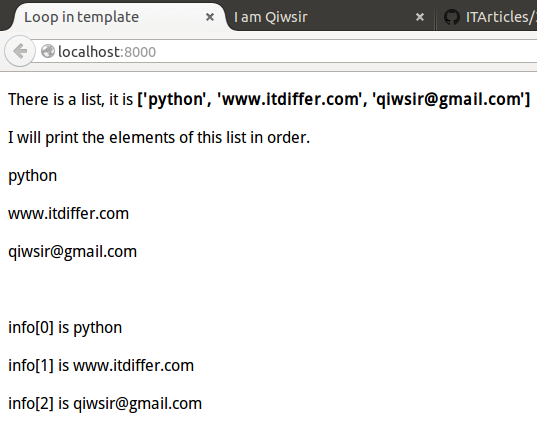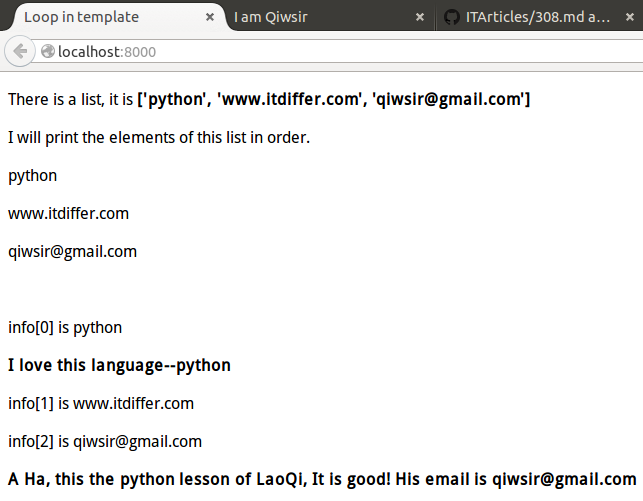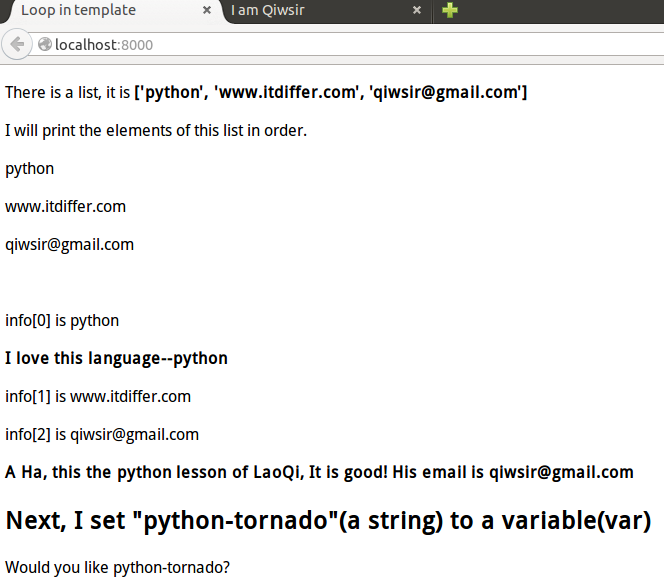"Come to me, all you that are weary and are carrying heavy burdens, and I will give you rest. Take my yoke upon you, and learn from me; for I am gentle and humble in heart, and you will find rest for your souls. For my yoke is easy, and my burden is light."(MATTHEW 12:28-30)
#模板中的语法
在上一讲的练习中,列位已经晓得,模板中{{placeholder}}可以接收来自python文件(.py)中通过self.render()传过来的参数值,这样模板中就显示相应的结果。在这里,可以将{{placeholder}}理解为占位符,就如同变量一样啦。
这是一种最基本的模板显示方式了。但如果仅仅如此,模板的功能有点单调,无法完成比较复杂的数据传递。不仅仅是tornado,其它框架如Django等,模板都有比较“高级”的功能。在tornado的模板中,功能还是很不少的,本讲介绍模板语法先。
##模板中循环的例子
在模板中,也能像在python中一样,可以使用某些语法,比如常用的if、for、while等语句,使用方法如下:
先看例子
先写一个python文件(命名为index.py),这个文件中有一个列表["python", "www.itdiffer.com", "[email protected]"],要求是将这个列表通过self.render()传给模板。
然后在模板中,利用for语句,依次显示得到的列表中的元素。
#! /usr/bin/env python
#-*- coding:utf-8 -*-
import os.path
import tornado.httpserver
import tornado.ioloop
import tornado.web
import tornado.options
from tornado.options import define, options
define("port", default=8000, help="run on the given port", type=int)
class IndexHandler(tornado.web.RequestHandler):
def get(self):
lst = ["python","www.itdiffer.com","[email protected]"] #定义一个list
self.render("index.html", info=lst) #将上述定义的list传给模板
handlers = [(r"/", IndexHandler),]
template_path = os.path.join(os.path.dirname(__file__), "temploop") #模板路径
if __name__ == "__main__":
tornado.options.parse_command_line()
app = tornado.web.Application(handlers,template_path)
http_server = tornado.httpserver.HTTPServer(app)
http_server.listen(options.port)
tornado.ioloop.IOLoop.instance().start()
模板文件,名称是index.html,在目录temploop中。代码如下:
<DOCTYPE html>
<html>
<head>
<title>Loop in template</title>
</head>
<body>
<p>There is a list, it is <b>{{info}}</b></p>
<p>I will print the elements of this list in order.</p>
{% for element in info %} <!-- 循环开始,注意写法类似python中的for,但是最后没有冒号 -->
<p>{{element}}</p> <!-- 显示element的内容 -->
{% end %} <!-- 结束标志 -->
<br>
{% for index,element in enumerate(info) %}
<p>info[{{index}}] is {{element}}
{% end %}
</body>
</html>
运行上面的程序:
>>> python index.py
然后在浏览器地址栏中输入:http://localhost:8000,显示的页面如下图:
在上面的例子中,用如下样式,实现了模板中的for循环,这是在模板中常用到的,当然,从python程序中传过来的不一定是list类型数据,也可能是其它类型的序列数据。
{% for index,element in enumerate(info) %}
<p>info[{{index}}] is {{element}}
{% end %}
特别提醒注意的是,语句要用{% end %}来结尾。在循环体中,用{{ element }}方式使用序列的元素。
##模板中的判断语句
除了循环之外,在模板中也可以有判断,在上面代码的基础上,改写一下,直接上代码,看官想必也能理解了。
index.py的代码不变,只修改模板index.html的代码,重点理解模板中的语句写法。
<DOCTYPE html>
<html>
<head>
<title>Loop in template</title>
</head>
<body>
<p>There is a list, it is <b>{{info}}</b></p>
<p>I will print the elements of this list in order.</p>
{% for element in info %}
<p>{{element}}</p>
{% end %}
<br>
{% for index,element in enumerate(info) %}
<p>info[{{index}}] is {{element}}
{% if element == "python" %} <!-- 增加了一个判断语句 -->
<p> <b>I love this language--{{element}}</b></p>
{% end %}
{% end %}
{% if "[email protected]" in info %} <!-- 还是判断一下 -->
<p><b>A Ha, this the python lesson of LaoQi, It is good! His email is {{info[2]}}</b></p>
{% end %}
</body>
</html>
上面的模板运行结果是下图样子,看官对比一下,是否能够理解呢?
##模板中设置变量
废话不说,直接上例子,因为例子是非常直观的:
<DOCTYPE html>
<html>
<head>
<title>Loop in template</title>
</head>
<body>
<p>There is a list, it is <b>{{info}}</b></p>
<p>I will print the elements of this list in order.</p>
{% for element in info %}
<p>{{element}}</p>
{% end %}
<br>
{% for index,element in enumerate(info) %}
<p>info[{{index}}] is {{element}}
{% if element == "python" %}
<p> <b>I love this language--{{element}}</b></p>
{% end %}
{% end %}
{% if "[email protected]" in info %}
<p><b>A Ha, this the python lesson of LaoQi, It is good! His email is {{info[2]}}</b></p>
{% end %}
<h2>Next, I set "python-tornado"(a string) to a variable(var)</h2>
{% set var="python-tornado" %}
<p>Would you like {{var}}?</p>
</body>
</html>
显示结果如下:
看官发现了吗?我用{% set var="python-tornado" %}的方式,将一个字符串赋给了变量var,在下面的代码中,就直接引用这个变量了。这样就是实现了模板中变量的使用。
Tornado的模板真的功能不少呢。不过远非这些,后面还有。敬请等待。


